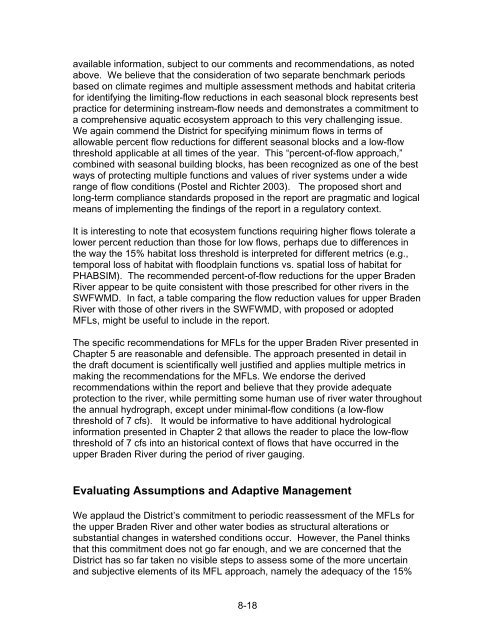Chapter 1 Minimum Flows and Levels - Southwest Florida Water ...
Chapter 1 Minimum Flows and Levels - Southwest Florida Water ...
Chapter 1 Minimum Flows and Levels - Southwest Florida Water ...
You also want an ePaper? Increase the reach of your titles
YUMPU automatically turns print PDFs into web optimized ePapers that Google loves.
available information, subject to our comments <strong>and</strong> recommendations, as noted<br />
above. We believe that the consideration of two separate benchmark periods<br />
based on climate regimes <strong>and</strong> multiple assessment methods <strong>and</strong> habitat criteria<br />
for identifying the limiting-flow reductions in each seasonal block represents best<br />
practice for determining instream-flow needs <strong>and</strong> demonstrates a commitment to<br />
a comprehensive aquatic ecosystem approach to this very challenging issue.<br />
We again commend the District for specifying minimum flows in terms of<br />
allowable percent flow reductions for different seasonal blocks <strong>and</strong> a low-flow<br />
threshold applicable at all times of the year. This “percent-of-flow approach,”<br />
combined with seasonal building blocks, has been recognized as one of the best<br />
ways of protecting multiple functions <strong>and</strong> values of river systems under a wide<br />
range of flow conditions (Postel <strong>and</strong> Richter 2003). The proposed short <strong>and</strong><br />
long-term compliance st<strong>and</strong>ards proposed in the report are pragmatic <strong>and</strong> logical<br />
means of implementing the findings of the report in a regulatory context.<br />
It is interesting to note that ecosystem functions requiring higher flows tolerate a<br />
lower percent reduction than those for low flows, perhaps due to differences in<br />
the way the 15% habitat loss threshold is interpreted for different metrics (e.g.,<br />
temporal loss of habitat with floodplain functions vs. spatial loss of habitat for<br />
PHABSIM). The recommended percent-of-flow reductions for the upper Braden<br />
River appear to be quite consistent with those prescribed for other rivers in the<br />
SWFWMD. In fact, a table comparing the flow reduction values for upper Braden<br />
River with those of other rivers in the SWFWMD, with proposed or adopted<br />
MFLs, might be useful to include in the report.<br />
The specific recommendations for MFLs for the upper Braden River presented in<br />
<strong>Chapter</strong> 5 are reasonable <strong>and</strong> defensible. The approach presented in detail in<br />
the draft document is scientifically well justified <strong>and</strong> applies multiple metrics in<br />
making the recommendations for the MFLs. We endorse the derived<br />
recommendations within the report <strong>and</strong> believe that they provide adequate<br />
protection to the river, while permitting some human use of river water throughout<br />
the annual hydrograph, except under minimal-flow conditions (a low-flow<br />
threshold of 7 cfs). It would be informative to have additional hydrological<br />
information presented in <strong>Chapter</strong> 2 that allows the reader to place the low-flow<br />
threshold of 7 cfs into an historical context of flows that have occurred in the<br />
upper Braden River during the period of river gauging.<br />
Evaluating Assumptions <strong>and</strong> Adaptive Management<br />
We applaud the District’s commitment to periodic reassessment of the MFLs for<br />
the upper Braden River <strong>and</strong> other water bodies as structural alterations or<br />
substantial changes in watershed conditions occur. However, the Panel thinks<br />
that this commitment does not go far enough, <strong>and</strong> we are concerned that the<br />
District has so far taken no visible steps to assess some of the more uncertain<br />
<strong>and</strong> subjective elements of its MFL approach, namely the adequacy of the 15%<br />
8-18
















